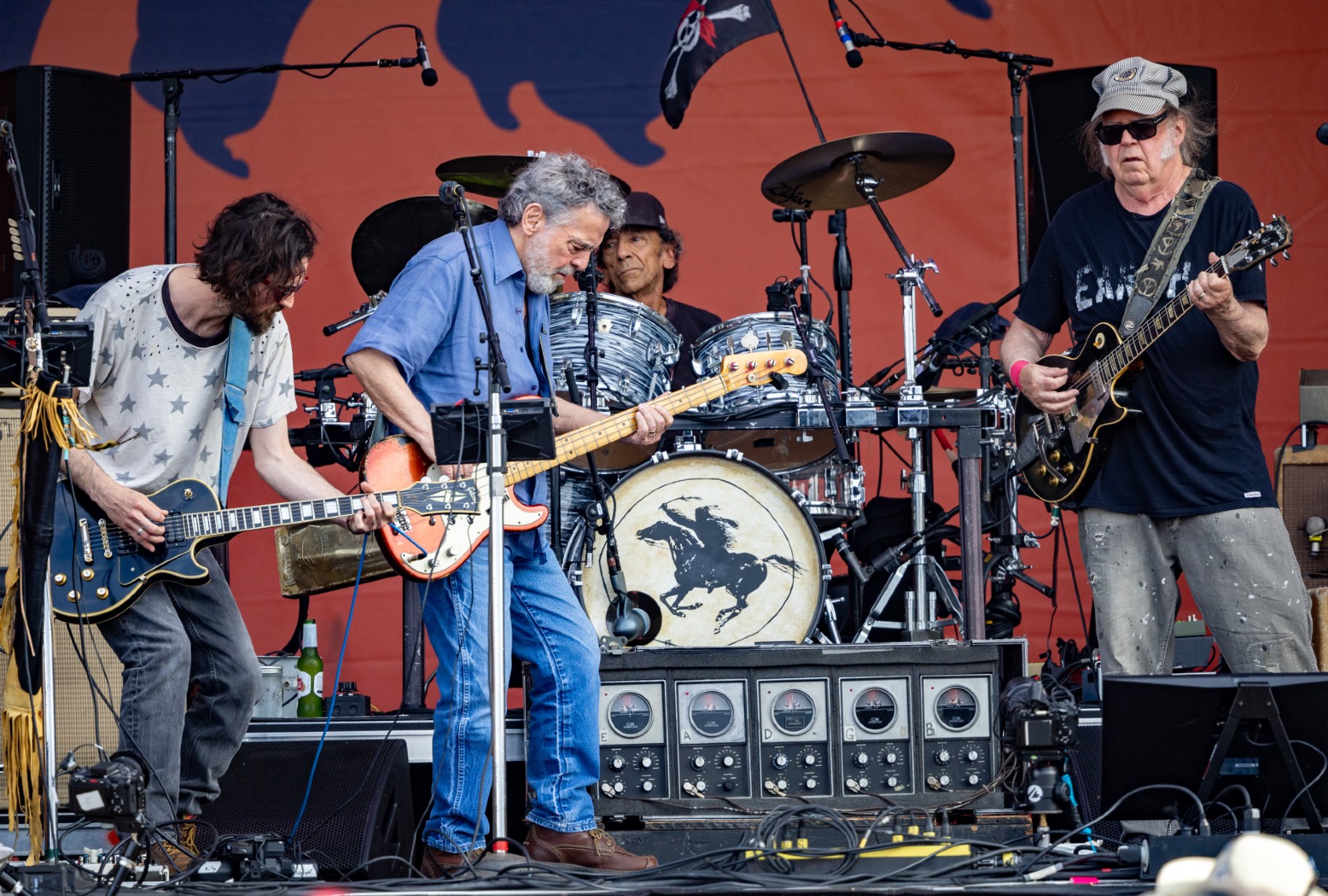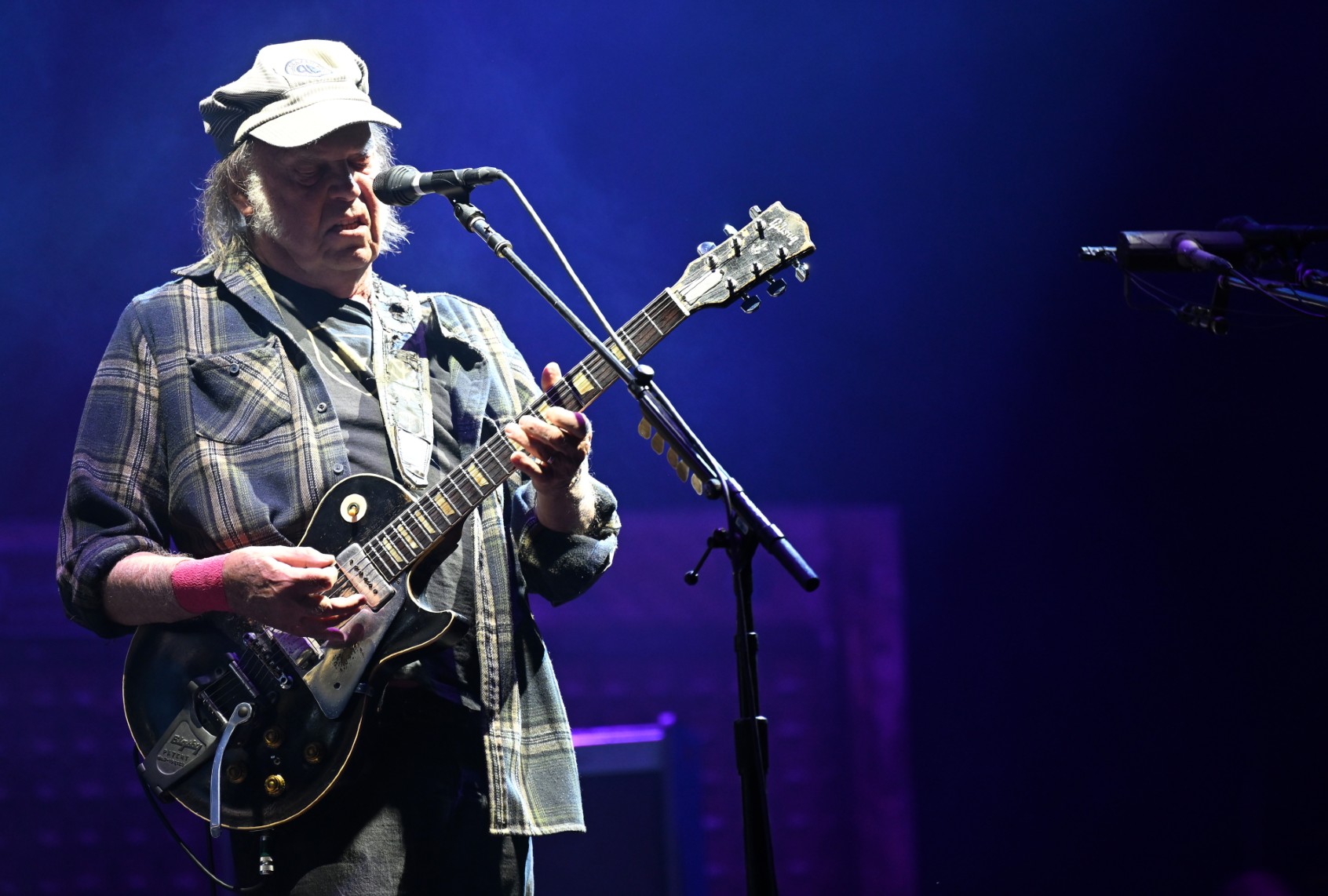Neil Young is on tour this summer with the chrome hearts (Micah Nelson — guitar, Corey McCormick — bass, Anthony LoGerfo — drums and Spooner Oldham — keyboards) on the continuation of what Young has dubbed the “Love Earth” tour. After a trip around the European festival circuit earlier this summer (including an appearance at Glastonbury’s Pyramid Stage), the band arrived back home at the beginning of August. The setlists in Europe appeared from the outside to be what you’d expect to see from a renowned rocker out on a Euro summer outing, loaded with hits to appeal to thousands of people standing in a field.
That isn’t meant as any kind of criticism because Neil Young’s catalog of hits is formidable, and the European festivals keep many American rock bands afloat for the rest of the year. But somewhere around the beginning of July, there was a shift, a change: “Ambulance Blues,” the epic closing number from 1974’s “On the Beach,” became the opening number, and the rest of the set began to coalesce into a more loosely thematic form.
“Ambulance Blues” is the kind of rarity that would make a Neil Young fan not holding tickets to this summer’s U.S. outing pay close attention and maybe rethink that decision (guilty as charged) but it’s not just because it’s rare, it’s because it is a monster of a song, an absolute epic. The opening notes incur full-body goosebumps in an August summer heat just from the power of being in its presence out at Pine Knob, the famed outdoor amphitheater located in the Detroit suburbs.
What must it feel like to have written stories that were true 60 years ago and are true once again?
But the likely motivation for this particular setlist addition would reveal itself in the song’s last verse, which begins: “I never knew a man could tell so many lies.” A wave of audible recognition rolled up the amphitheatre as Young continued the rest of the verse: “He had a different story for every set of eyes / How can he remember who he’s talkin’ to? / ‘Cause I know it ain’t me, and I hope it isn’t you.” “Ambulance Blues” is deliberately opaque — as Neil says in the lyrics, “It’s hard to say the meaning of this song” — but it’s still a song steeped in disillusionment, written at the end of the ’60s when Richard Nixon was in office.
A couple of songs down, “Be the Rain,” from 2003’s criminally underrated “Greendale,” dropped some more breadcrumbs. “Save the planet for another day,” it opens. “Don’t care what the government says/They’re all bought and paid for anyway.” It’s an exhortation and an anthem — “Be the rain you remember falling” — the emotional peak of a song cycle about a girl named Sun Green who’s trying to save the Earth.
Start your day with essential news from Salon.
Sign up for our free morning newsletter, Crash Course.
“Cortez the Killer” shimmers into existence, and a listener might contemplate that while it’s another one of Young’s monumental mid-’70s mythic journeys, it’s also essentially a story about imperialism. “Southern Man”? It’s probably a little glib to declare it a song about reparations, but it’s also not an incorrect observation. “Southern Man” garnered a huge and immediate roar from the audience that was part simple recognition of one of his most legendary and well-known compositions (it was everywhere on FM radio back in the day, but it did not chart), but it also felt like a collective assent. It’s not a song you dance in the aisles to, but it is a song that got most of the crowd to their feet, applauding.
The tour’s full band debut of “Ohio” was electric and in your face. The audience once again roared in recognition, and it always feels like a privilege to be in the room when Neil decides to bring this one out. The concert I attended on Wednesday was the year’s first appearance of this particular number, which was, of course, composed, recorded and released in quick succession in response to the 1970 murders of four students at Kent State. The last time Young played this live was on May 4, 2024, the 54th anniversary of the event, onstage at the New Orleans Jazz & Heritage Festival.

(Douglas Mason/WireImage/Getty Images) (L-R) Micah Nelson, Billy Talbot, Ralph Molina and Neil Young of Crazy Horse perform during the 2024 New Orleans Jazz & Heritage Festival
When Young played “Ohio” at Jazz Fest, a local critic noted that Young had performed the song but that he hadn’t offered any “commentary.” “What if you knew her and/Found her dead on the ground” seems pretty clear and unambiguous, as does the repetition of “Four dead in Ohio.” There is more than one way to offer commentary. And further along in the set, an absolutely ethereal “Love and Only Love,” from 1990’s “Ragged Glory,” reminded us “hate is everything you think it is.”
What must it feel like to have written stories that were true 60 years ago and are true once again?
But also? This show absolutely and thoroughly rocked and was everything you would want to experience seeing Neil Young perform live. “Cowgirl in the Sand” lasted a glorious 14 minutes as Young, Nelson and McCormick carefully conjured nothing short of a maelstrom by the song’s end; it felt like religion. The aforementioned “Cortez the Killer” offered its usual pathways for creative guitar-based meanderings.
“Cinnamon Girl” was ecstatic, perfectly loud and crunchy, and the one-two punch towards the end of the set with “Hey Hey, My My (Into the Black)” and “Like a Hurricane” were enormous, rock solid, and incredibly satisfying. There isn’t an audience alive that isn’t going to be delighted to be able to yell, “Rock and roll will never die” in unison with each other and to immerse themselves in the rolling wall of power chords emanating from the stage.
But Neil and the chrome hearts would also swap their axes for acoustic guitars. “One of These Days” was a welcome respite, and “Harvest Moon” (both from the eponymous 1992 release) was a huge hit with the crowd. Couples sweetly danced together at their seats and back on the lawn. The band members impressively stepped into the stunningly gorgeous harmonies of “New Mama,” Young’s delicate and heartwarming paean written after the birth of his first son.
There isn’t an audience alive that isn’t going to be delighted to be able to yell, “Rock and roll will never die” in unison with each other.
The chrome hearts in their other lives are members of Lukas Nelson and the Promise of the Real, who have been backing Neil on and off for the last decade and then the legendary keyboardist Spooner Oldham, member of the Rock and Roll Hall of Fame and best known for his work as part of the Muscle Shoals Rhythm Section. The one negative to the performance I caught is that his work on the Hammond B3 was completely inaudible in the mix from your critic’s location, stage left and halfway up the seating bowl. This is unfortunate on every front.
It’s interesting to consider the line between some of Neil’s backing bands: of course, there’s Crazy Horse, Young’s work with Pearl Jam (aka “Neil Jam”) in the ’90s, Booker T and the MG’s, 2000’s The Friends and Relatives (which included Spooner Oldham) and the Promise of the Real, and how Neil has a tremendous knack in pulling together first-rate collections of musicians aligned to support where he is at any given moment.
The vibe onstage with the chrome hearts is somewhere between the institution that was Crazy Horse and the genre-defying moment that was Neil Jam: there’s respect but tons of energy, and they’re all clearly having fun up there. There was a moment at the end of “The Loner” (another tour debut!) where Neil stretched his arms out, almost bird-like, to enhance the sustain on his guitar and Micah Nelson struck the same pose — likely for the same reason, as the two faced each other, grinning so broadly you could have seen it on the lawn.
Sometimes you don’t know how much you need to hear some songs live until you’re standing there, in front of the speakers, surrounded by other humans.
And while there’s also a lot of personality emanating from the chrome hearts, no one onstage is trying to reinterpret the songs from outside their known, established frameworks. They are 100% true and correct to the original versions — except, of course, in the jams, where everyone ranges out and around, trying to keep pace with Neil, before backing up and getting the hell out of his way when he heads off on a solo.
During “Southern Man,” Micah Nelson walked over to an old, battered upright piano and admirably acquitted himself in the shading and spirit of Nils Lofgren’s work on the original. Right before “Like A Hurricane,” a folk art sculpture that looked like some kind of avenging angel was lowered to the stage, and with much hand-waving (no one could hear it in the monitors, apparently), we discovered that the contraption hid a keyboard which Micah Nelson jammed on as it swung back and forth, before the figure was sent back up into the rafters.
The set ended with the lovely ballad “Old Man” from Young’s 1972 classic album “Harvest,” where it seemed like every single person in the audience was singing along, and then the band returned and strapped on the electric guitars one more time for a rousing and cathartic “Rockin’ In The Free World,” which isn’t an uncommon closer for Young but, like some of the other topical material covered earlier in the set, has never stopped being true.
Sometimes you don’t know how much you need to hear some songs live until you’re standing there, in front of the speakers, surrounded by other humans. It doesn’t even matter how many times you’ve listened to those songs or seen them performed; as the man himself has said, “Live music is better.” There’s no statute of limitations on how music and art are, and continue to be, transformative and affirming and uplifting and just plain joyous. We are so lucky that at the age of 80, this man still wants to get onstage and do this for us.
Read more
from music columnist Caryn Rose


